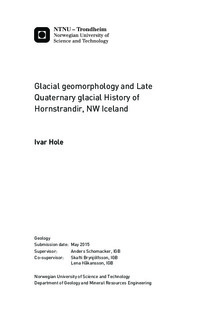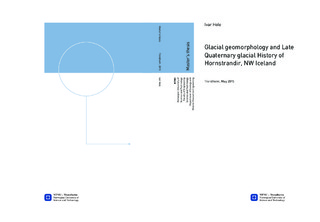| dc.description.abstract | The Late Quaternary and Holocene glacial history of Hornstrandir, NW Iceland, have been investigated. The area is of special interest because it s almost unstudied. Several researchers have proposed that ice free plateaux and nunataks existed in Iceland during the Last Glacial Maximum (LGM) and Hornstrandir has been considered a likely candidate for such conditions.
Methods such as geomorphological mapping, sediment descriptions of coastal sections and sampling of material for radiocarbon dating, tephra and cosmogenic exposure dating have been applied. Detailed geomorphological maps of the area are also presented. Landforms such as terminal and lateral moraines, hummocky moraines, flutes, rock glaciers, rivers and lakes have been mapped by detailed field investigations and by visual interpretation of orthorectified aerial photographs.
Cosmogenic exposure dating has demonstrated that the entire Hornstrandir was covered by ice during the LGM. Cold based ice that preserved the periglacial surface beneath, was situated on the upland plateaux. Coastal sections have shown that cirque glaciers in Hornstrandir coalesced to form valley glaciers that flowed northwards towards the shelf break. The plateaux didn t deglaciate until 18 14 kyr BP. During the Bølling Interstadial, sea level stood at least 5 9 m above the present. By Younger Dryas time, cirque glaciers in Hornstrandir once again formed glaciers that at least reached out to the present coast. Terminal moraines have been used to estimate that the total glaciated area at some point during deglaciation was 44 km2. The Saksunarvatn tephra (erupted 10180 ± 60 cal. yr BP) has been sampled at two locations, indicating that most of Hornstrandir was ice-free at Preboreal time. Neoglaciation on Hornstrandir is reflected in raised beaches yielding ages between ~2100 1300 cal. yr BP. During the Little Ice Age (LIA) cirque glaciers reached their Holocene maximum. The total glaciated area during the LIA has been estimated to 8.2 km2. | |

